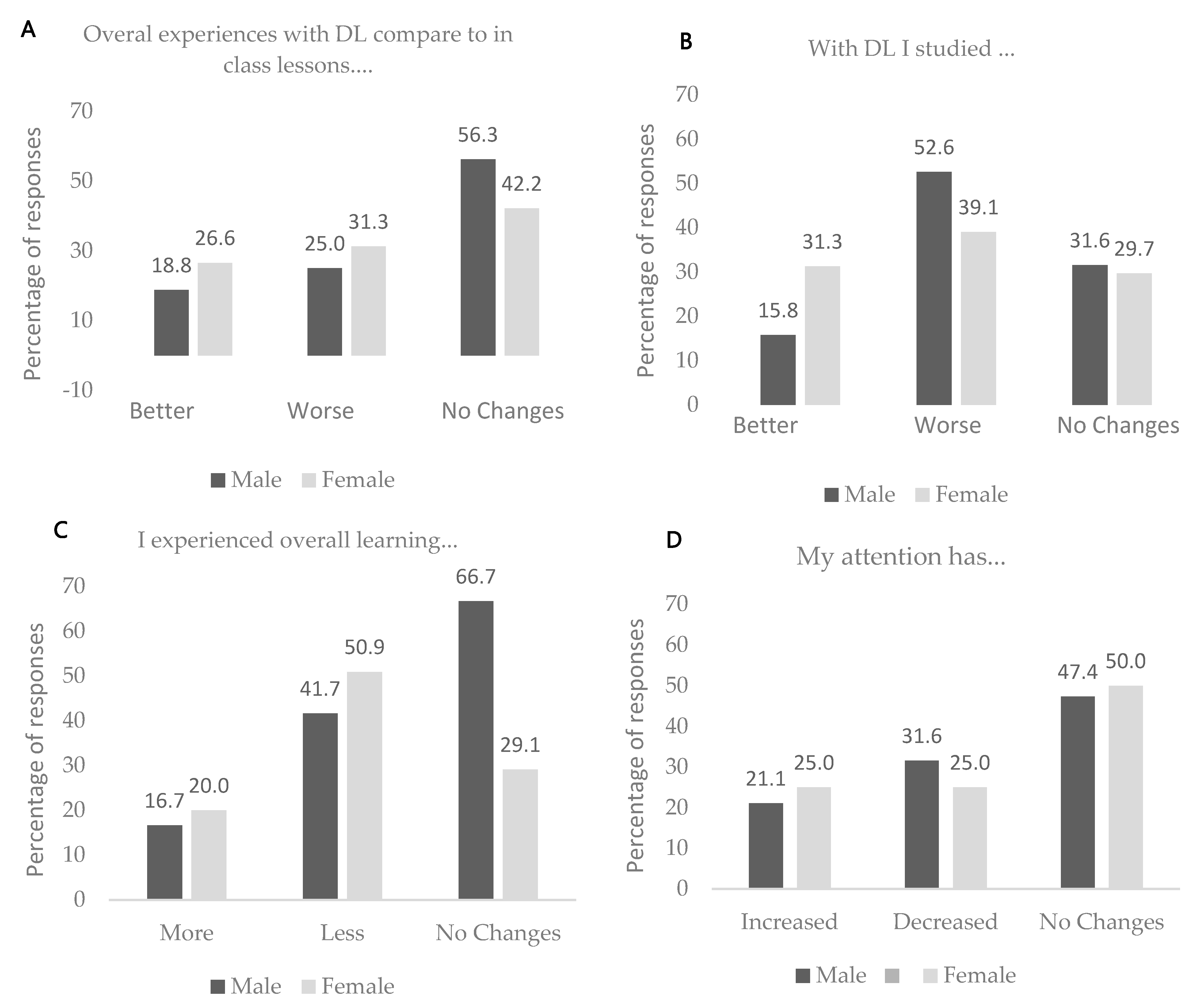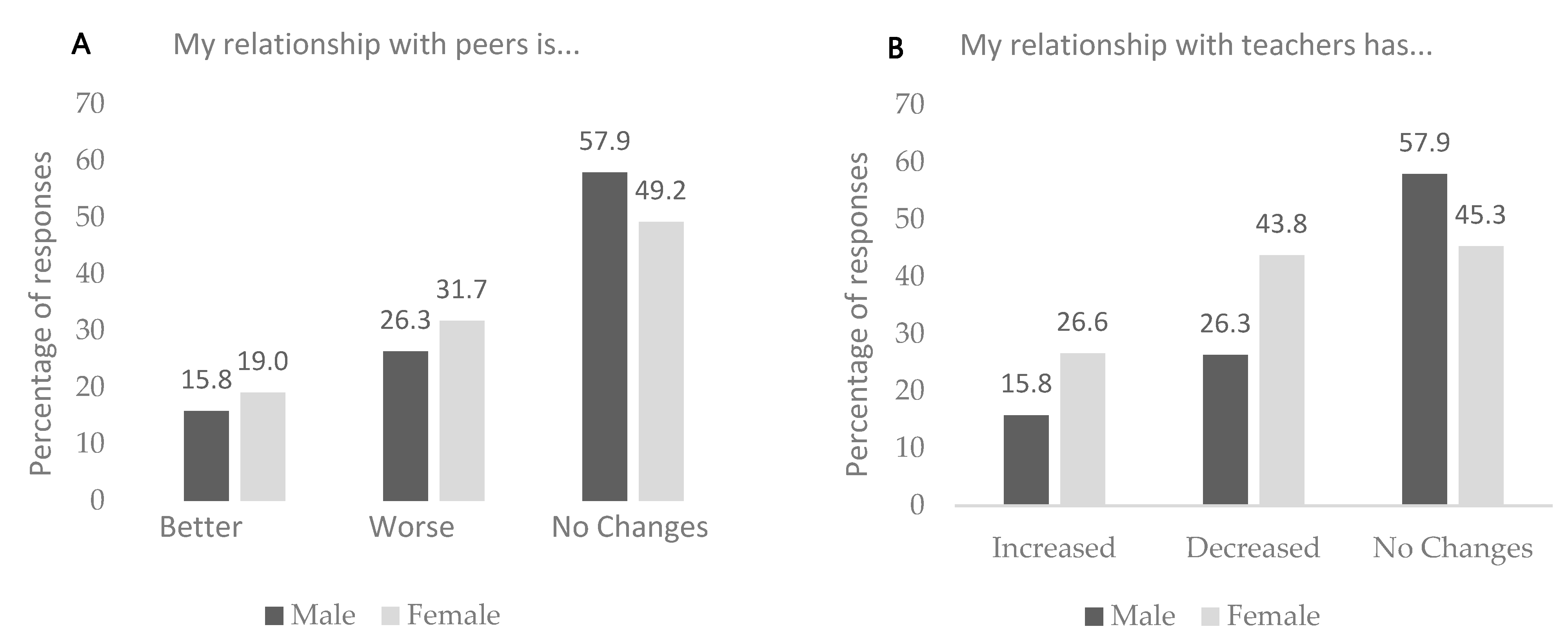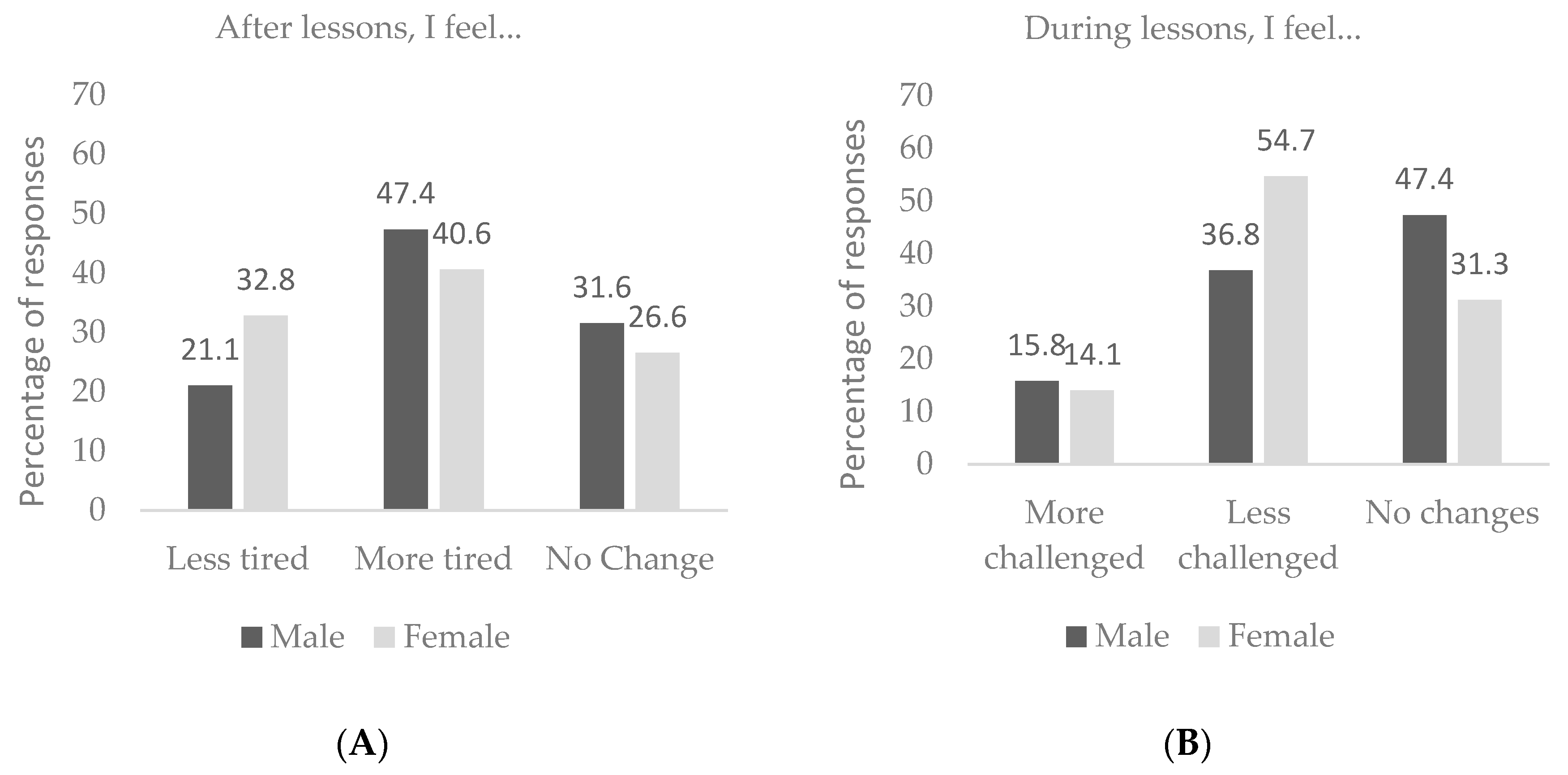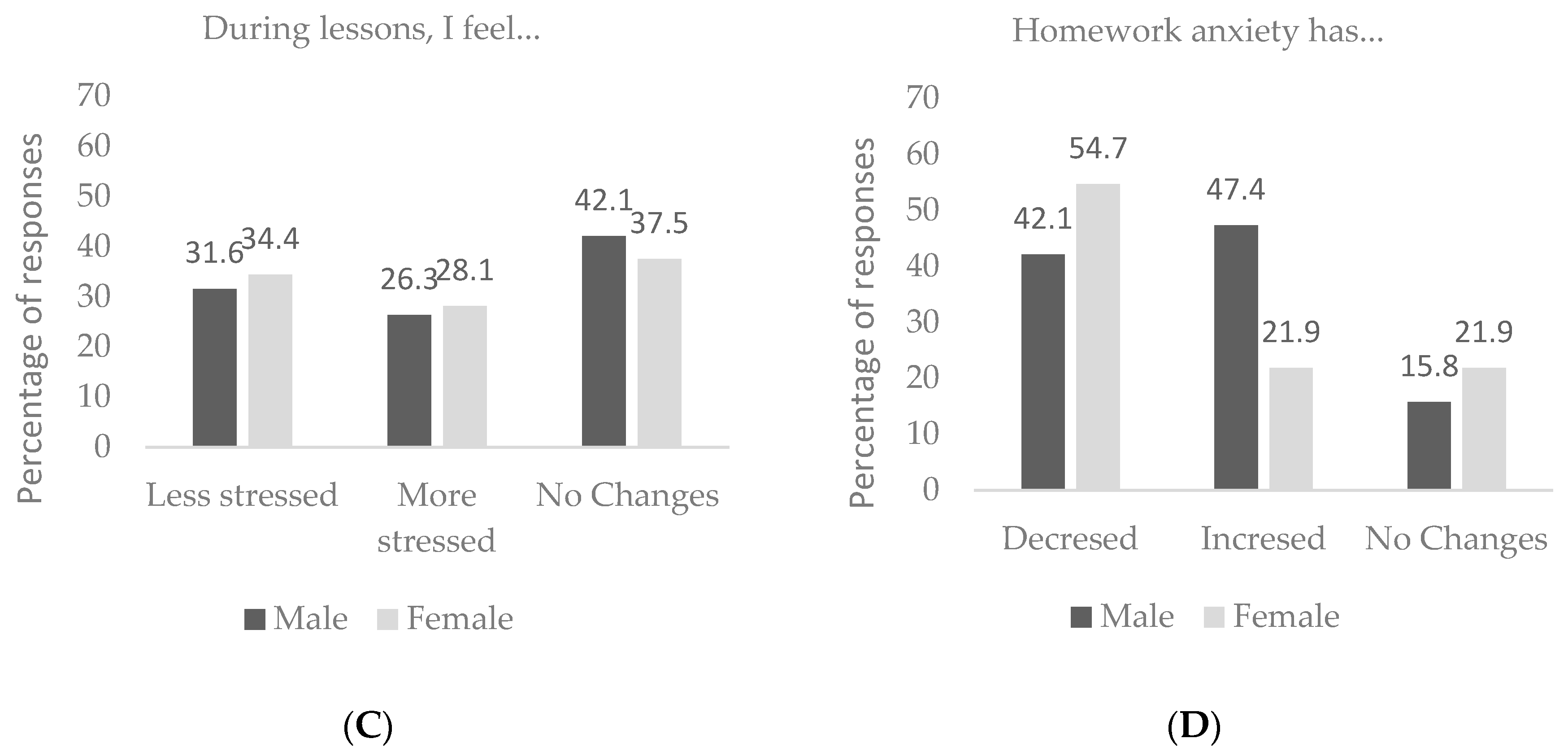Distance Learning in the COVID-19 Era: Perceptions in Southern Italy
Abstract
1. Introduction
2. Materials and Methods
2.1. General Design
2.2. Participant Characteristics
2.3. Data Analysis
3. Results
4. Discussion
5. Conclusions and Limitations
Author Contributions
Funding
Acknowledgments
Conflicts of Interest
References
- Wu, Z.; McGoogan, J.M. Characteristics of and important lessons from the coronavirus disease 2019 (COVID-19) outbreak in China: Summary of a report of 72 314 cases from the Chinese Center for Disease Control and Prevention. JAMA 2020, 323, 1239–1242. [Google Scholar] [CrossRef] [PubMed]
- Velavan, T.P.; Meyer, C.G. The COVID-19 epidemic. Trop. Med. Int. Health 2020, 25, 278. [Google Scholar] [CrossRef] [PubMed]
- Baldwin, R.; Weder di Mauro, B. Economics in the Time of COVID-19; CEPR Press: London, UK, 2020. [Google Scholar]
- Armocida, B.; Formenti, B.; Ussai, S.; Palestra, F.; Missoni, E. The Italian health system and the COVID-19 challenge. Lancet Public Health 2020, 5, e253. [Google Scholar] [CrossRef]
- Pfefferbaum, B.; North, C.S. Mental health and the Covid-19 pandemic. N. Engl. J. Med. 2020, 383, 510–512. [Google Scholar] [CrossRef]
- Chen, E.; Kaczmarek, K.; Ohyama, H. Student perceptions of distance learning strategies during COVID-19. J. Dent. Edu. 2020, 1–2. [Google Scholar] [CrossRef]
- Cook, D.A.; Dupras, D.M. A practical guide to developing effective web-based learning. J. Gen. Intern. Med. 2004, 19, 698–707. [Google Scholar] [CrossRef]
- Clark, J.T. Distance Education. In Clinical Engineering Handbook; Elsevier: Amsterdam, The Netherlands, 2020; pp. 410–415. [Google Scholar]
- Gibbs, G. Teaching Students to Learn: A Student-Centered Approach. Available online: https://www.scirp.org/(S(i43dyn45teexjx455qlt3d2q))/reference/ReferencesPapers.aspx?ReferenceID=478920 (accessed on 27 November 2020).
- Zibers, B.; Estes, J.S. Creating a Virtual Reality Lab: Using a Student-Centered Approach. In Current and Prospective Applications of Virtual Reality in Higher Education; IGI Global: Pennsylvania, PA, USA, 2020; pp. 145–169. [Google Scholar]
- Rossi, R.; Socci, V.; Talevi, D.; Mensi, S.; Niolu, C.; Pacitti, F.; Di Marco, A.; Rossi, A.; Siracusano, A.; Di Lorenzo, G. COVID-19 pandemic and lockdown measures impact on mental health among the general population in Italy. Front. Psychiatry 2020, 11, 790. [Google Scholar] [CrossRef]
- Pellegrini, M.; Maltinti, C. ‘School Never Stops’: Measures and Experience in Italian Schools during the COVID-19 Lockdown. Best Evid. Chin. Educ. 2020, 5, 649–663. [Google Scholar] [CrossRef]
- Pisano, L.; Galimi, D.; Cerniglia, L. A Qualitative Report on Exploratory Data on the Possible Emotional/Behavioral Correlates of Covid-19 Lockdown in 4–10 Years Children in Italy. Available online: https://psyarxiv.com/stwbn/ (accessed on 27 November 2020).
- Lakhan, R.; Agrawal, A.; Sharma, M. Prevalence of Depression, Anxiety, and Stress during COVID-19 Pandemic. J. Neurosci. Rural Pract. 2020, 11, 519. [Google Scholar] [CrossRef]
- Sher, L. The impact of the COVID-19 pandemic on suicide rates. QJM Int. J. Med. 2020, 113, 707–712. [Google Scholar] [CrossRef]
- Iavarone, M.L.; Trocchia, N. Il Coraggio Delle Cicatrici: Storia Di Mio Figlio Arturo E Della Nostra Lotta; Utet: Milan, Italy, 2020. [Google Scholar]
- Iavarone, M.L.; Iavarone, T. Pedagogia del Benessere. Per Una Professionalità Educativa in Ambito Psico-Socio-Sanitario. 2004. Available online: https://sites.google.com/site/quitchiwcapitor3/9788846457677-71nestfrunGEhaulu50 (accessed on 27 November 2020).
- Iavarone, M.L. Alta Formazione Per Lo Sviluppo Educativo Locale. 2009. Available online: https://www.amazon.com/Alta-formazione-sviluppo-educativo-locale-ebook/dp/B007QQHS1A (accessed on 27 November 2020).
- Pierluigi, M.; Maria, L.I.; Luigina, M.; Teresa, G.; Maria, G.R.; Roberto, F.; Milena, S.; Lucia, C.C.; Loiodice, I.; Massimiliano, F. Landascape education as italian contribution to the implementation of the Agenda 2030. Pedagogia OGGI 2018, 1, 259–276. Available online: https://fair.unifg.it/handle/11369/370309?mode=full.699#.X8CWS-cRU2w (accessed on 27 November 2020).
- Iavarone, M.L. Curare i margini. Riprendersi il senso dell’educazione per prevenire il rischio. Annali Online Della Didattica Della Formazione Docente 2019, 11, 1–5. [Google Scholar]
- Ambra, F.I.; Ferraro, F.V.; Ferra, V.; Basile, S.; Girardi, F.; Menafro, M.; Iavarone, M.L.; Napoli, A.S.L.A.; Centro, N.O.d.N. Impact of sport training on healthy behavior in a group of 108 adolescents: A pilot study using SMART questionnaire. Well-being Educ. Syst. 2019, 1, 43–47. [Google Scholar]
- Ferraro, F.V.; Ambra, F.I.; Iavarone, M.L. Evaluation of Health-Habits with the S.M.A.R.T. Questionnaire: An Observational Study. Educ. Sci. 2020, 10, 285. [Google Scholar] [CrossRef]
- Landry, M.; Turner, M.; Vyas, A.; Wood, S. Social Media and Sexual Behavior Among Adolescents: Is there a link? JMIR Public Health Surveill. 2017, 3, e28. [Google Scholar] [CrossRef] [PubMed]
- Endendijk, J.J.; Groeneveld, M.G.; Bakermans-Kranenburg, M.J.; Mesman, J. Gender-Differentiated Parenting Revisited: Meta-Analysis Reveals Very Few Differences in Parental Control of Boys and Girls. PLoS ONE 2016, 11, e0159193. [Google Scholar] [CrossRef]
- Stonard, K.E. Technology-assisted adolescent dating violence and abuse: A factor analysis of the nature of electronic communication technology used across twelve types of abusive and controlling behaviour. J. Child Fam. Stud. 2019, 28, 105–115. [Google Scholar] [CrossRef]
- Gao, J.; Zheng, P.; Jia, Y.; Chen, H.; Mao, Y.; Chen, S.; Wang, Y.; Fu, H.; Dai, J. Mental health problems and social media exposure during COVID-19 outbreak. PLoS ONE 2020, 15, e0231924. [Google Scholar] [CrossRef]
- Sarabia, I.; Estévez, A. Sexualized behaviors on Facebook. Comput. Hum. Behav. 2016, 61, 219–226. [Google Scholar] [CrossRef]
- Peris, M.; de la Barrera, U.; Schoeps, K.; Montoya-Castilla, I. Psychological risk factors that predict social networking and internet addiction in adolescents. Int. J. Environ. Res. Public Health 2020, 17, 4598. [Google Scholar] [CrossRef]
- Frost, R.L.; Rickwood, D.J. A systematic review of the mental health outcomes associated with Facebook use. Comput. Hum. Behav. 2017, 76, 576–600. [Google Scholar] [CrossRef]
- Leena, K.; Tomi, L.; Arja, R. Intensity of mobile phone use and health compromising behaviours—How is information and communication technology connected to health-related lifestyle in adolescence? J. Adolesc. 2005, 28, 35–47. [Google Scholar] [CrossRef] [PubMed]
- Crawford, J.; Butler-Henderson, K.; Rudolph, J.; Malkawi, B.; Glowatz, M.; Burton, R.; Magni, P.; Lam, S. COVID-19: 20 countries’ higher education intra-period digital pedagogy responses. J. Appl. Learn. Teach. 2020, 3, 1–20. [Google Scholar]
- Ambra, F.I.; Ferraro, .F.V.; Girardi, F.; Iavarone, M.I. Distanced learning between educational and technological barriers: A survey in the Campania Region (Italy) with secondary school students. Attual. Pedagog. Dec. 2020. [Google Scholar]
- Ambra, F.I.; Ferraro, .F.V.; Girardi, F.; Iavarone, M.I. Towards a teaching that reduces the distance: First results of a survey of the effects of distance learning on secondary school students. Excell. Innov. Teach. Learn. 2020. under review. [Google Scholar]
- Symonds, E. A practical application of SurveyMonkey as a remote usability-testing tool. Library Hi Tech 2011, 29, 436–445. [Google Scholar] [CrossRef]
- Mulya, A.P.; Lukman, M.; Yani, D.I. Correlation of Media and Parents Role to Adolescent Sexual Behavior. J. Nurs. Care 2020, 3. Available online: http://jurnal.unpad.ac.id/jnc/article/download/26747/13868 (accessed on 27 November 2020).
- Mayhew, A.; Weigle, P. Media engagement and identity formation among minority youth. Child Adolesc. Psychiatr. Clin. 2018, 27, 269–285. [Google Scholar] [CrossRef]
- Hernandez-de-Menendez, M.; Díaz, C.A.E.; Morales-Menendez, R. Educational experiences with Generation, Z. Int. J. Interact. Des. Manuf. (IJIDeM) 2020, 14, 847–859. [Google Scholar] [CrossRef]
- Strauss, W.; Howe, N. Generations: The History of America’s Future, 1584–2069; William Morrow: New York, NY, USA, 1991. [Google Scholar]
- PrakashYadav, G.; Rai, J. The Generation Z and their social media usage: A review and a research outline. Glob. J. Enterp. Inf. Syst. 2017, 9, 110–116. [Google Scholar]
- Twenge, J.M.; Spitzberg, B.H.; Campbell, W.K. Less in-person social interaction with peers among US adolescents in the 21st century and links to loneliness. J. Soc. Pers. Relatsh. 2019, 36, 1892–1913. [Google Scholar] [CrossRef]
- Thomas, L.; Orme, E.; Kerrigan, F. Student loneliness: The role of social media through life transitions. Comput. Educ. 2020, 146, 103754. [Google Scholar] [CrossRef]
- Rajamohan, S.; Bennett, E.; Tedone, D. The hazards and benefits of social media use in adolescents. Nursing 2019, 49, 52–56. [Google Scholar] [CrossRef] [PubMed]
- Cilliers, E.J. The challenge of teaching generation Z. PEOPLE Int. J. Soc. Sci. 2017, 3, 188–198. [Google Scholar] [CrossRef]
- Lenihan, A. Investigating language policy in social media: Translation practices on Facebook. In The Language of Social Media; Springer: Berlin/Heidelberg, Germany, 2014; pp. 208–227. [Google Scholar]
- Tække, J.; Paulsen, M. Distraction and digital media: Multiplexing, not multitasking in the classroom. Læring Og Medier 2019, 21, 1–14. [Google Scholar]
- Posselt, J.R.; Lipson, S.K. Competition, anxiety, and depression in the college classroom: Variations by student identity and field of study. J. Coll. Stud. Dev. 2016, 57, 973–989. [Google Scholar] [CrossRef]
- Downing, V.R.; Cooper, K.M.; Cala, J.M.; Gin, L.E.; Brownell, S.E. Fear of negative evaluation and student anxiety in community college active-learning science courses. CBE Life Sci. Educ. 2020, 19, ar20. [Google Scholar] [CrossRef]
- Barraket, J. Teaching Research Method Using a Student-Centred Approach? Critical Reflections on Practice. J. Univ. Teach. Learn. Pract. 2005, 2, 3. [Google Scholar]
- Lobb, H. A student-centred approach to teaching. Agora 2020, 55, 23. [Google Scholar]
- Al-Balushi, S.M.; Ambusaidi, A.K.; Al-Balushi, K.A.; Al-Hajri, F.H.; Al-Sinani, M.S. Student-centred and teacher-centred science classrooms as visualized by science teachers and their supervisors. Teach. Teach. Educ. 2020, 89, 103014. [Google Scholar] [CrossRef]
- Kember, D. Promoting student-centred forms of learning across an entire university. High. Educ. 2009, 58, 1–13. [Google Scholar] [CrossRef]
- Lucisano, P. Fare ricerca con gli insegnanti. I primi risultati dell’indagine nazionale SIRD “Per un confronto sulle modalità di didattica a distanza adottate nelle scuole italiane nel periodo di emergenza COVID-19”. Lifelong Lifewide Learn. 2020, 16, 3–25. [Google Scholar]
- Gewin, V. Five tips for moving teaching online as COVID-19 takes hold. Nature 2020, 580, 295–296. [Google Scholar] [CrossRef] [PubMed]




| Software | Percentage |
|---|---|
| 26.5% | |
| Zoom | 25.3% |
| Other | 20.5% |
| Skype | 19.3% |
| Microsoft Teams | 6.0% |
| CISCO | 2.4% |
| Location | Percentage |
| Own room | 68.7% |
| Different room | 30.1% |
| Device | Percentage |
| Computer | 43.4% |
| Smartphone/tablet | 56.5% |
| Multitasking | Percentage |
| Yes | 95.2% |
| No | 4.8% |
| Classes (n) | Percentage | Hours of Lessons (h) | Percentage |
|---|---|---|---|
| 1 | 1.2 | 1 | 3.6 |
| 2 | 0.0 | 2 | 10.8 |
| 3 | 0.0 | 3 | 42.2 |
| 4 | 7.2 | 4 | 34.9 |
| 5 | 14.5 | 5 | 20.5 |
| 6 | 20.5 | 6 | 1.2 |
| 7 | 24.1 | 7 | 0.0 |
| 8 | 24.1 | 8 | 2.4 |
| 9 | 8.4 | ||
| 10 | 1.2 | ||
| 11 | 7.2 |
Publisher’s Note: MDPI stays neutral with regard to jurisdictional claims in published maps and institutional affiliations. |
© 2020 by the authors. Licensee MDPI, Basel, Switzerland. This article is an open access article distributed under the terms and conditions of the Creative Commons Attribution (CC BY) license (http://creativecommons.org/licenses/by/4.0/).
Share and Cite
Ferraro, F.V.; Ambra, F.I.; Aruta, L.; Iavarone, M.L. Distance Learning in the COVID-19 Era: Perceptions in Southern Italy. Educ. Sci. 2020, 10, 355. https://doi.org/10.3390/educsci10120355
Ferraro FV, Ambra FI, Aruta L, Iavarone ML. Distance Learning in the COVID-19 Era: Perceptions in Southern Italy. Education Sciences. 2020; 10(12):355. https://doi.org/10.3390/educsci10120355
Chicago/Turabian StyleFerraro, Francesco Vincenzo, Ferdinando Ivano Ambra, Luigi Aruta, and Maria Luisa Iavarone. 2020. "Distance Learning in the COVID-19 Era: Perceptions in Southern Italy" Education Sciences 10, no. 12: 355. https://doi.org/10.3390/educsci10120355
APA StyleFerraro, F. V., Ambra, F. I., Aruta, L., & Iavarone, M. L. (2020). Distance Learning in the COVID-19 Era: Perceptions in Southern Italy. Education Sciences, 10(12), 355. https://doi.org/10.3390/educsci10120355





